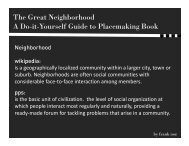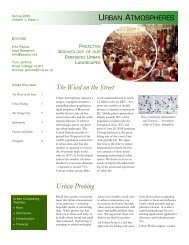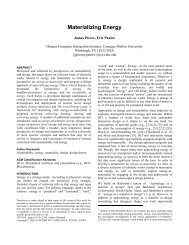Chapter 5: Modeling Users: Personas and Goals
Chapter 5: Modeling Users: Personas and Goals
Chapter 5: Modeling Users: Personas and Goals
Create successful ePaper yourself
Turn your PDF publications into a flip-book with our unique Google optimized e-Paper software.
<strong>Personas</strong><br />
<strong>Chapter</strong> 5: <strong>Modeling</strong> <strong>Users</strong>; <strong>Personas</strong> <strong>and</strong> <strong>Goals</strong> 77<br />
To create a product that must satisfy a diverse audience of users, logic might tell<br />
you to make it as broad in its functionality as possible to accommodate the most<br />
people. This logic, however, is flawed. The best way to successfully accommodate a<br />
variety of users is to design for specific types ofindividuals with specific needs.<br />
When you broadly <strong>and</strong> arbitrarily extend a product's functionality to include many<br />
constituencies, you increase the cognitive load <strong>and</strong> navigational overhead for all<br />
users. Facilities that may please some users will likely interfere with the satisfaction<br />
of others (see Figure 5~ 1).<br />
"<br />
Figure 5·1 A simplified example of how personas are useful. If you try to design<br />
an automobile that pleases every possible driver, you end up with a car with every<br />
possible feature, but that pleases nobody. Software today is too ohen designed<br />
to please too many users, resulting in low user satisfaction. Figure 5-2 provides an<br />
ernative approach.<br />
key to this approach is first to choose the right individuals to design for_<br />
users whose needs best represent the needs ofa larger set ofkey constituents<br />
Figure 5-2) - <strong>and</strong> then to prioritize these individuals so that the needs ofthe<br />
important users are met without compromising Our ability to meet the needs<br />
ndary users. <strong>Personas</strong> provide a powerful tool for communicating about dif~<br />
types of users <strong>and</strong> their needs, then deciding which users are the most<br />
nt to target in the design of form <strong>and</strong> behavior.<br />
were introduced as a tool for user modeling in The Inmates are Running<br />
m,l personas have gained great popularity in the user experience commu<br />
Ihey have also been the subject of some misunderst<strong>and</strong>ings. We'd like to<br />
explain in more depth some of the concepts <strong>and</strong> the rationale behind












